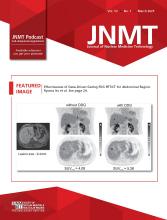Abstract
The SNMMI EANM Procedure Guide on Gastrointestinal Transit currently indicates that the mean of total abdominal counts of seven time points (0-360 min) are used to define the total abdominal counts for bowel transit studies. The purpose of this study was to investigate the variability of total abdominal counts during the initial six hours of bowel transit and to determine if a simplified, single time point measurement can be used. METHODS: Thirty consecutive bowel transit studies were retrospectively analyzed. Patients received an oral dose of 4.6 MBq(125 µCi) 111In-DTPA in 300 cc of water together with a standard egg white solid-phase, gastric emptying meal to measure small bowel and colon transit. 111In-DTPA geometric mean and decay corrected total abdominal counts obtained at 0, 30, 60, 120, 180, 240, 300, and 360 minutes post meal ingestion were analyzed. The coefficient of variation (CV) was used to determine the variability of the mean total abdominal counts. Slope of the regression line, Student’s t-test and a Pearson Product-Moment Correlation Coefficient (PCC) were also calculated to determine the correlation of total abdominal counts at each time point compared to the mean of all time points. RESULTS: The mean CV of total abdominal counts of each patient was 3.3% with a range of 1.1% to 6.3%. The mean of the slope of the regression line of the total abdominal counts of the patients was -0.001±0.003. There was no significant difference between the measured slope of the regression line compared to a line with a slope of 0 (p>0.05). Comparing the counts at each time to the mean counts, there was no significant difference (p>0.05). The PCC of each of the counts showed a significant and strong correlation between each interval and the mean total abdominal counts (p<0.01).







